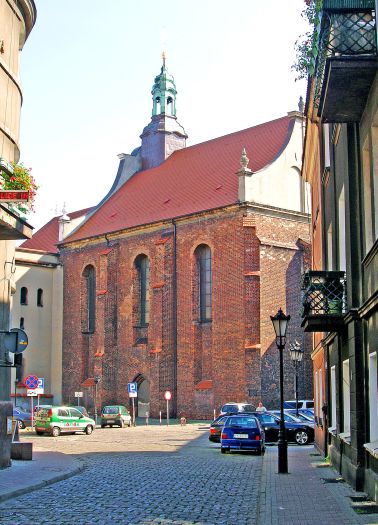
Worth Seeing
The centre point of Kalisz is the main marketplace and town hall from 1924. The city retains its medieval urban layout and narrow streets despite being destroyed in 1914. All this is visible from the town hall tower.
The Gothic St. Nicholas Church is the main place of worship. Peter Paul Rubens’s painting The Descent from the Cross was the most valuable historical relic in the (originally Regular Canons) church. The canvass disappeared in 1973.
The Voivodeship School was built on the site of the medieval castle in 1819. Apart from the Pope John Paul II monument, the baroque Assumption of the Virgin Mary Basilica – St. Joseph Sanctuary, and the post-Jesuit complex and early-baroque church (Poland’s most important example of Roman baroque architecture) founded by Abp. Stanisław Karnkowski, Primate of All Poland, in 1595, are the most important historical buildings in St. Joseph Square. The original Jesuit monastery was rebuilt in 1829 as the palace of the Voivodeship Commission (now the main office of the Starostwo) in a neoclassical style. The Cadet Corps operated in the other part of the former Jesuit building (in ul. Sukiennicza) from 1795 to 1831. A part of the defensive walls of Dorota Keep and, further on, a piece of the neo-Byzantine St. Peter and St. Paul Orthodox church have been preserved behind the basilica.
The Franciscan church, built in 1256, is the oldest place of worship in Kalisz. The outside of the building has a mostly Gothic character.
Kamienny Bridge,built in 1826, is one of many across the Prosna.
The elegant Al. Wolności (Freedom Blvd) is to the left of the bridge. This street, laid down by the Prussians, has reflected the history of the city through its many name changes from the Prussian Queen Louise to the Empress Josephine, Hermann Göring and Joseph Stalin. This is one of the few well preserved parts of Kalisz from before 1914. The facade of the 1824 tribunal building was modelled on the Louvre in Paris. The development of the boulevard ends with Czesław Przybylski’s scenically located 1923 theatre building. The entrance to Park Miejski (City Park) is by the theatre. The statue of Flora (one of the symbols of the city) is a reminder of the many romantic buildings that once stood here.
Crossing Kamienny Bridge leads straight to a post-reformation church built in 1665-1673. The three oldest maintained Lutheran, Orthodox and Catholic cemeteries are a little further on, next to the old Wrocław tollgate (built in 1826; now a sweet shop).
Some of the many places worth visiting:
• the partially reconstructed grad in Zawodzie which predates the founding of Kalisz. Miesko III the Old (d. 1202), Duke of Wielkopolska, was buried in the defunct Collegiate Church of St. Paul. The 18th-century wooden St. Wojciech Church is beside the archaeological reserve.
• The former baroque Bernardine (now Jesuit) church with its rococo frescoes has operated as the world’s first Sacred Heart Sanctuary since 1998.
• The neo-Romanesque prison (ul. Łódzka) from 1843, which looks like a medieval castle from the outside and is still functioning.
• The neo-classicist Puchalski Palace (pl. Kilińskiego) from 1830, which combines the features of a manor house and a tenement building. Maria Konopnicka lived here.
• The Repphan Brothers’ factory (pl. Kilińskiego), Kalisz’s largest textile mill from 1824 to 1910.
• The drill hall of the former Cadet Corps (ul. Łazienna) from 1825, now the head office of the Centre of Culture and Art.
• The Jewish quarter (ul. Złota) and Jewish cemetery (ul. Podmiejska) from 1919. This has many macebas from defunct necropolises. The former pre-funeral home (for the tahara ritual) is now the House of Remembrance and contains mementos of Kalisz’s onetime Jewish community.
• The Kalisz District Museum (ul. Kościuszki) – houses collections connected with the history of the city and the region, a library of rare prints and 19th-century Kalisz periodicals.
For more information, go to:
www.kalisz.pl/en










